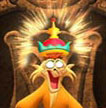 After lunching with animators Andreas Deja and Eric Goldberg and talking with them about their experiences and projects over the years at the Walt Disney Studios, Animated News’ Christian Ziebarth recently met up again with Goldberg, the famed lead animator of the Genie in Aladdin and co-director on Pocahontas and Looney Tunes: Back In Action. He and his work can also be seen on the recent DVD release of Steve Martin’s The Pink Panther, the traditionally animated title sequence to which he greatly contributed. Among the chat’s highlights are Eric speaking about his recent short A Monkey’s Tale, the many changes currently occurring at the Walt Disney Studio, its past history, and where things are headed in Feature Animation’s exciting future. This exclusive discussion can be read right now, right here:
After lunching with animators Andreas Deja and Eric Goldberg and talking with them about their experiences and projects over the years at the Walt Disney Studios, Animated News’ Christian Ziebarth recently met up again with Goldberg, the famed lead animator of the Genie in Aladdin and co-director on Pocahontas and Looney Tunes: Back In Action. He and his work can also be seen on the recent DVD release of Steve Martin’s The Pink Panther, the traditionally animated title sequence to which he greatly contributed. Among the chat’s highlights are Eric speaking about his recent short A Monkey’s Tale, the many changes currently occurring at the Walt Disney Studio, its past history, and where things are headed in Feature Animation’s exciting future. This exclusive discussion can be read right now, right here:
Animated News: So, at the risk of starting with an understatement, what have you been up to since we last spoke?
Eric Goldberg: I’ve just finished doing an eight-minute cartoon called A Monkey’s Tale for a Buddhist cultural center outside of Hong Kong. The Ngong Ping Village attraction (Ngong Ping 360 as they are officially calling it) was built by the MTR Corporation near the world famous Tian Tan Big Buddha. It’s one of two films produced for the attraction, each being housed in their own specialized theaters. A Monkey’s Tale is in the, what else, Monkey Tale Theatre and is projected as a triptych by three high-definition projectors, fifteen feet high by forty-eight feet wide, and the basic premise is that it is a little parable about greed, and my handling of it gagged it up considerably. It’s produced by Allen Yamashita, who came up with the original story concept, and Oric Scott De Las Casas. Martin Zurauskas was the executive producer and Kaye Robinson was co-producer, and I had on it my kind of core repertory company: Susan [Goldberg, Eric’s wife] did the art direction, Scott Johnston was the visual effects director, and Bert Klein was my lead animator. They all did a sterling job and for a while we were the only 2D employment in town. We had about fifteen animators and about 45 cleanup artists. They’d just come off of Curious George, and were waiting for Enchanted, and we kind of got them from one monkey to the next. We had some fabulous animators but it was very gruelling to do it. The story is that there are three monkeys trying to steal a peach from the hand of the ancient statue of the Monkey King, and the action’s all played out in pantomime other than the occasional monkey noise. The monkeys are named Clever, Doofus and Tag-a-long. Clever is the schemer, he’s the one who gets the other two to do his bidding for him. To me it’s kind of Buddhism gagged up, but the Buddhist monks seem to like it. Clever is in the Sylvester and Coyote vein, and Doofus is a doofus, deadpan most of the time, and Tagalong’s like the little brother you can’t get rid of. Basically, once we had the premise and there were some rough storyboards done by Dean Wellins, they kind of let me run with it in terms of putting a lot of content into it and really making the characters alive, giving them specific personality. It was a difficult job to do because it was formatted on a sextuple sixteen field, basically six sixteen field pieces of paper comprised the screen, so mechanically it was very difficult for every one to work on. We had to work that large because it’s going to be in high definition, so we had to make sure all the drawings were going to be large enough to really hold up, and everyone did a magnificent job. I’m so proud of everyone’s work on it and hopefully despite the fact that it was difficult to do everybody came back saying, “These characters are fun to draw.” It’s kind of a good old-fashioned cartoon in a way of the type that isn’t made that often these days.
AN: And that’s going to be playing near Disneyland Hong Kong?
EG: Yes, very near Disneyland Hong Kong on Lantau Island. Now, I say “film” but it’s environmental, so we have in-house gags like when something gets destroyed there’s dust that spews out over the audience, when rain occurs there’s actual physical rain in the theater. We’ve got 360-degree sound. There are gags that go all the way around the theater. And obviously this one is quite whimsical compared to the other film that they are doing, Walking With Buddha, which is directed by my producers on this film, Allen Yamashita and Oric Scott De Las Casas. It’s much more serious, about the life of Buddha. I think they cast me right to do the funny one.
AN: You mentioned Scott Johnston doing the visual effects. And he’s the one who did the wildebeest stampede sequence in The Lion King?
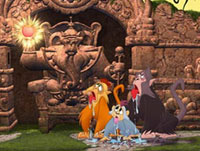 EG: Yeah, he was the visual effects director and he utilized a similar technique to that which he created on Looney Tunes: Back In Action, which he called “Lumo,” and that takes two-dimensional drawings and lights them. It’s quite marvelous. So Susan and Scott would work together. She did the color script, and then they got together and they would determine how that was going to translate in terms of where they place the lights. You could tell Susan’s touch was all over, all the whacked-out colors during the lightning flashes, things like that, and the bizarro colors for the nightmare which I think are great. She just went to town with the colors. And Scott is a genius, I mean his ability to get things as perfect as possible, he’s quite a stickler for perfection, and, second of all, he has a lot of creativity in terms of, “We should do X and Y and that will give us Z,” because he knows all this computer stuff backwards and forwards, partially because he created much of it himself. There were things, for example, that we could only do with Scott’s programming.
EG: Yeah, he was the visual effects director and he utilized a similar technique to that which he created on Looney Tunes: Back In Action, which he called “Lumo,” and that takes two-dimensional drawings and lights them. It’s quite marvelous. So Susan and Scott would work together. She did the color script, and then they got together and they would determine how that was going to translate in terms of where they place the lights. You could tell Susan’s touch was all over, all the whacked-out colors during the lightning flashes, things like that, and the bizarro colors for the nightmare which I think are great. She just went to town with the colors. And Scott is a genius, I mean his ability to get things as perfect as possible, he’s quite a stickler for perfection, and, second of all, he has a lot of creativity in terms of, “We should do X and Y and that will give us Z,” because he knows all this computer stuff backwards and forwards, partially because he created much of it himself. There were things, for example, that we could only do with Scott’s programming.
AN: He was a kind of pioneer of the whole computer animation thing?
EG: He really is, yeah. When the light went over as the crown is hovering over Clever’s head, I had wanted kind of a hot rim on Clever to be shining down from that crown and he could just do it with his program; I didn’t have to draw anything, you know; so it was one of those things where Scott had to deal with all those little things, plus the monster organization that it took to pull this off from so many different artists, having it inked and painted in Korea, and just trying to collate all this stuff, and he didn’t have a lot of time to do the final and it sure turned out great. The look is very crisp. Since it’s done for three high-definition projectors, it’s going to be “crisp” when you see it. It was grueling to produce; I mean, honestly, I lost sleep night after night after night. I pulled so many all-nighters on this thing. So did a lot of people.
AN: I remember one time you told me, “Yeah, I stay up late working all night.”
EG: Yeah, that’s what I was doing on this. It was monstrous, we didn’t have enough money for it, but it was the opportunity to do a big, glorious hand-drawn cartoon. Now, it certainly utilizes the computer to give it that look, and to composite, but there isn’t any CG animation, it’s all hand-drawn. And we just had great people, we had Caroline Cruikshank, Andreas Wessel-Therhorn, Theresa Wiseman, Frans Vischer, Tony de Rosa, Tom Roth, Bert and Jennifer Klein; I mean, we had great, great people. And in cleanup we had Emily Jiuliano, June Fujimoto, we had Brian Clift, and Jody Kooistra, who is a goldmine, she’s great. She’s fast and wonderful. We just had the cream of people on this thing.
AN: I bet they were all available.
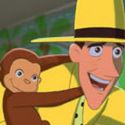 EG: Well, here’s the funny thing: there used to be this assistant back in the Eighties named Don Selders – I came to know him through Tom Roth. He was working with Tom when we were all working at Richard Williams’ doing Ziggy’s Gift, and Don had this way of equating animation to migrant farm working: one job finishes then you pick up the basket and you move on! That’s exactly what the animation industry, at least in hand-drawn, is doing right now. So, basically, they all came off Curious George and worked on our show, and now they’ve all gone to work on Enchanted. I had no knowledge of anything that was being done on Curious George when this was made. So much depends first of all on the enthusiasm of the crew for a project and, second of all, just on a clear idea of knowing what they’re supposed to do. Curious George had such growing pains that everybody was trying to repair it as they were making it. This was all mapped out for everybody, and there’s a notion that if it’s all posed out then you’re just pre-chewing it for the animator, but when all the animators got into it, they said, “That’s a lot of work. That’s a lot of work once we start animating,” and the fact of the matter is, yes, of course it’s a lot of work because they’re making it live. If I’m hitting poses it’s not the same as animating. It’s like a Chuck Jones/Ken Harris/Ben Washam thing; okay, maybe Chuck did the poses but those guys made it live and they’re master animators.
EG: Well, here’s the funny thing: there used to be this assistant back in the Eighties named Don Selders – I came to know him through Tom Roth. He was working with Tom when we were all working at Richard Williams’ doing Ziggy’s Gift, and Don had this way of equating animation to migrant farm working: one job finishes then you pick up the basket and you move on! That’s exactly what the animation industry, at least in hand-drawn, is doing right now. So, basically, they all came off Curious George and worked on our show, and now they’ve all gone to work on Enchanted. I had no knowledge of anything that was being done on Curious George when this was made. So much depends first of all on the enthusiasm of the crew for a project and, second of all, just on a clear idea of knowing what they’re supposed to do. Curious George had such growing pains that everybody was trying to repair it as they were making it. This was all mapped out for everybody, and there’s a notion that if it’s all posed out then you’re just pre-chewing it for the animator, but when all the animators got into it, they said, “That’s a lot of work. That’s a lot of work once we start animating,” and the fact of the matter is, yes, of course it’s a lot of work because they’re making it live. If I’m hitting poses it’s not the same as animating. It’s like a Chuck Jones/Ken Harris/Ben Washam thing; okay, maybe Chuck did the poses but those guys made it live and they’re master animators.
AN: They still have room for their own interpretation.
EG: Absolutely. It has to be in there. If it isn’t, the characters aren’t alive, they’re not invested in the characters. And I do it on a sliding scale; on a job that’s huge I have to have it done fairly quickly, I’ll usually go the pose-out method; on a job where there’s a little more leeway, like on the Disney features, I won’t pose it out, I’ll let the animators find their feet and in both cases we’re talking about acting, we’re talking about how you’re conveying what the characters are going through. So even though the pose represents something I still thoroughly brief all the animators as to the thought process. In any case, I’m very happy with the way it turned out. It now has its final score and its final soundtrack, and for the animation industry it does them proud.
AN: So, for those of us who can’t make it to Hong Kong, are we going to be able to see this anywhere else? Are you going to be able to show it around at film festivals?
EG: There is a strong potential. The nice thing about it is that as we were making it we realized it was going to be more than just something created for the venue, that it was actually turning out well and that it still played like a self-contained cartoon even if it wasn’t in the venue. Now, the venue augments it greatly because it has 360-degree sound and it has in-house gags for the lightning and for the smoke and things like that, but it still plays like a cartoon; like a film that had a beginning, a middle, and an end and I wanted it to work that way. I had that kind of construction. So, yeah, we’re going to see how it does. Early response by those lucky enough to see it has been very, very positive.
AN: I just went to a screening of Over the Hedge and they showed a nice little short called First Flight. It was really good, and I thought, “I wonder if they’re going to start showing shorts more in theaters again?”
EG: Right now the only way it happens is for big companies to invest in them, like a DreamWorks or a Pixar, and I also know that Disney’s is going to start a shorts program. But in order to run them they have to place them at the head of their features. It’s not like shorts that used to be rented separately. On Cartoon Brew there’s somebody who came up with a website about having found records of what was rented in what year and for how much. And that’s really telling; you could tell what cartoons were popular and what weren’t but that was all part of block booking too. Basically the studios owned half the theaters so that instance was, “Well, if you want Casablanca you have to rent Bugs Bunny.” That situation doesn’t exist anymore. So it’s not going to happen unless the big studios support it. Lots of independent shorts are still made but they don’t necessarily find a big distribution, which is a shame, and it’s also because theater owners won’t go to the trouble of renting them because they can squeeze one more showing of the feature in per day. That’s why they all died in the first place. First the block booking was destroyed by a court case; basically the Supreme Court brought the anti-trust laws down on them [the studios] and so the studios couldn’t do that anymore and they had to relinquish ownership of a lot of theaters. And then when it was put in an either/or situation: “Okay, we’re not block booking anymore but do you want Bugs Bunny?” “Nah, I’ll get in one more showing of Dr. Zhivago!” And that’s really why it persists to this day. Over the last fifteen years movies have become more and more like television. You go in and you see a plethora of commercials and a plethora of trailers. I remember when you used to go to the movies and you would see trailers and that’s it, and that’s one thing that separated going to the movies from TV. Now you’re seeing blowups of what they run on TV in bad 35 millimeter.
AN: Car commercials.
EG: Yeah. It’s like, what’s the point? I imagine the theater owners are happier because it helps subsidize them. And they get screwed by the studios.
AN: And they try to make up for it at the concession stands.
EG: Or as they call them in ShoWest [the industry’s trade fair], “The Profit Centers.” I could waffle on about movie distribution, but the big problem for all movies these days is the way the profit structure is centered now. Even back during Aladdin a theater would make a profit if it ran there for a year. What happens now is that studios now get the lion’s share of the profits in the first two weeks. Then if it gets held over then the profits start to trickle back to the cinema owners, but if they feel in that first opening weekend that it’s not going to fly, it’s out. So a movie that’s taken three years to complete will be gone in a weekend. It’s like a Broadway opening, it closes in one night, except far more expensive. What it means is there can’t be any middle ground pictures. There can’t be any pictures that make a reasonable profit because they’re considered not worth it compared to things that make a huge profit. That’s why some people gamble so much with huge budgets. They figure you’ve got to spend a lot to get a lot. I don’t buy that.
AN: Last time we talked about Napoleon Dynamite.
EG: Yeah! That’s a success story and there should be more of those. It cost under half a million and made a hundred million in the theater and even more on DVD. That’s a hit, folks. So, something’s backwards, and I think the studios are starting to take note. I think there are less blockbusters these days. I think they are starting to understand maybe all that good cash for bad isn’t worth their while. And obviously at Oscar time it’s the independent films or smaller ones that get a look in. I mean look at the nominees this year. There weren’t really any major big pictures that were nominated for Best Picture, were there?
AN: Not really.
 EG: Capote, Good Night And Good Luck, Brokeback Mountain. Here’s an interesting thing: George Clooney couldn’t get the money for Good Night And Good Luck. He had a seven million dollar budget and none of the studios would pony up for it. He had to find independent financing because it was in black and white. And the black and white photography was beautiful.
EG: Capote, Good Night And Good Luck, Brokeback Mountain. Here’s an interesting thing: George Clooney couldn’t get the money for Good Night And Good Luck. He had a seven million dollar budget and none of the studios would pony up for it. He had to find independent financing because it was in black and white. And the black and white photography was beautiful.
AN: Yeah, it was. And Schindler’s List was black and white.
EG: Yeah, and that was beautiful. But, you know, Spielberg is Spielberg, too. Even so, I would think George Clooney has a little weight in this town, but even he can’t get low budget funding. It’s outrageous. Hats off to him and anyone else who tries to do it the different way.
AN: We were talking about theater budgets. Do you think the general public doesn’t appreciate the theater-going experience like they should? As much as they used to?
EG: With the digital age, which in most cases is wonderful, it’s also blurring the line like crazy. First of all, you’ve got a million different illegal downloads, you know, the latest Star Wars movie as it’s playing in the theaters; you can get it on your laptop. Also, with home DVDs you notice the window has shrunk considerably between a release in the movies and a DVD release because the studios are hungry to get that profit immediately. So there’s not even a chance for a movie to hang around a theater a year. That’s what I would call a blockbuster, not one that kills in its opening weekend and rakes in two hundred million. Those are few and far between.
AN: One of my brothers was downloading some newly released movie one time. He was like, “Oh, it’s going to be ready sometime tomorrow,” and I said, “Pay eight bucks to go watch it properly.”
EG: Yeah, I know. It’s like, what’s the point? And it’s better when you see it in the theater. The Academy always contends it’s better in the theater. In fact, a movie has to have a theatrical presentation to qualify in all divisions. The other thing that’s blurring the line is peoples’ home systems are getting more and more sophisticated. By the time you’ve got a 65″ plasma screen and surround sound in your own house it can look pretty good and there’s not some annoying guy behind you telling you what you’re watching.
AN: I noticed at the last Oscars the head of the Academy mentioned a couple times the “special-ness” of going to the theater.
EG: It’s true. It’s their agenda to actually put that at the forefront, that it should be a common, shared experience like storytelling used to be.
AN: That’s a good point, the shared experience of it, not just “cocooning” in your house and tuning the rest of society out.
EG: Yeah. The truth of the matter is, many people are just working so hard they don’t get a chance to actually go to the movies and kill an evening, not to mention the costs. That’s the other thing that brings it down. Say a first run movie’s ten bucks, okay? You’ve got a family of four, that’s forty bucks. And you decide to have dinner so that’s probably another fifty bucks. So you’re spending close to a hundred bucks to go to the movies in an evening. If you wait three months you can buy it on DVD for $19.99. It’s a huge difference.
AN: Buy or rent. Or Netflix.
EG: Absolutely. The good thing about the digital age is that so much more is available for perusal. So many of these things come with great special editions, extras, and stuff like that. Also, you have the opportunity to examine something. If you really like it you can just go back and say, “Hey, how did they do that?” It’s not the same as the shared experience, but I can see pros and cons in both. Ultimately, if you’re making movies you’re making them to be seen by a large number of people and I’ll tell you where it’s especially true is in comedies. You can watch a comedy at home and I don’t care how good the picture is you probably won’t laugh as hard than if the entire theater is laughing around you, and that’s a very, very different experience. And I think sometimes the emotional experiences are stronger too. If I’m sitting in Schindler’s List and the entire audience is tearing up, that’s very powerful. We should probably swing this back to animation some way!
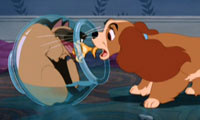 AN: Well, I was going to ask about Lady And The Tramp because I saw it at the El Capitan and it was wonderful. They projected it perfectly. They had a short and they had a special screen that was just the right dimensions for the short to be projected on, some short from around 1933, Mickey and Minnie. Everything just looked perfect. It was great being there with the crowd. So, I liked that experience but I, of course, also have the DVD, and you’re on it a lot!
AN: Well, I was going to ask about Lady And The Tramp because I saw it at the El Capitan and it was wonderful. They projected it perfectly. They had a short and they had a special screen that was just the right dimensions for the short to be projected on, some short from around 1933, Mickey and Minnie. Everything just looked perfect. It was great being there with the crowd. So, I liked that experience but I, of course, also have the DVD, and you’re on it a lot!
EG: Yeah, I’m afraid I am.
AN: Somebody was asking how that happens that you’re on Lady And The Tramp but you weren’t on Bambi?
EG: It’s when they ask me. I work with people over at Buena Vista Home Entertainment and they call me when they want me for a particular film. On Lady And The Tramp I happened to do far more than I had anticipated but that’s fine and I love the movie. And it was particularly nice to be able to do something about Joe Grant and giving him credit.
AN: Yeah, that was good.
EG: That to me is worth everything. And it’s a wonderful movie. The other good thing about digital, incidentally, when you were at that El Capitan screening it was a digital print they were showing. Those things are marvellous. We had digital high-definition prints supplied from Disney’s for our Sci-Tech night at the Academy and, my God, you could see everything, like on the Brave Little Tailor clips, things like that, oh my God, they were unbelievable. It was astounding how good they were when you see them projected in really high quality that way. So, if someone goes to the trouble of making a beautiful digital master and it can be shown in a movie theater that seems like the best of both worlds. Now there’s the occasional DVNR, Digital Video Noise Reduction. Sometimes when they do video transfers they put it through a program that tries to smooth it out and it means that in many cases if you single frame stuff you’re not actually getting a clean frame, you’re getting blurry frames because the stuff is moving too fast; usually okay for animation on twos, terrible for animation on ones. You can see it in, say, “The Big Snooze” on the Warners’ collection where all the bunnies are going over Elmer’s head as he’s tied on the railroad track. If you look at a standard print of the film they’re all clear; if you look at it on DVD they’re all blurry going over his head because they’ve done this noise reduction thing. However, outside of that, when they don’t do that kind of stuff some of the prints are truly astounding and wonderful and most of the Warners prints have been fantastic. It looks like they took a squeegee to the cartoons I grew up with and just cleared off all the gunk; there’s some that make my jaw drop because I go, “My God, was it really that color?” Although some of it’s twiddling, most of it, to my knowledge, is not.
AN: They do the best they can but they have to interpret somewhere.
EG: Hans Bacher, who used to do the transfers for Disney’s once in a while when he was still there, he said, “I just set it to pure black and pure white and let it go”, and he had the original film neg, and when he did that that meant that all the grading was correct! Yes, he could tweak things here and there if he wants to but, to be honest, that was his normal, very logical way of setting it. He’s very good at color. So he did the transfer on Make Mine Music and stuff like that, and even though they don’t have all the dust cleaned off of it it’s a very good transfer of that material.
AN: Did you notice any errors like DVNR in Lady And The Tramp?
EG: No. Lady And The Tramp looked gorgeous. Just as I remembered it.
AN: I thought it was really good that you mentioned Joe Grant’s contribution and pretty much starting the whole thing.
EG: That wasn’t my idea. Stan Deneroff, one of the guys who’s working at BVHE, I believe it was his concept and other folks there, so they knew where they wanted to go. It was nice to be a part of it, let’s put it that way, and I had a very personal relationship with Joe. Susan had a personal relationship with Joe, and it’s great that those guys wanted to see to it that he got credit. There are some good-hearted folks over at Disney’s who care very much about the legacy. They have become fewer and farther between but many are still there and with the current changes they’re trying to recapture some of that.
AN: Speaking of the current changes, and it might be cliched to ask, but what do you think of the Disney/Pixar deal?
EG: All I can say is it seems like good news for everybody.
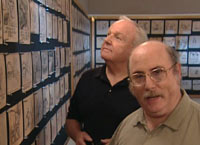 AN: One final Lady And The Tramp question: how did the storyboard featurette on the DVD come about from the 1943 version?
AN: One final Lady And The Tramp question: how did the storyboard featurette on the DVD come about from the 1943 version?
EG: I regret the introduction we shot for that, because it made it look like Burny [Mattinson] and I went into the archives and dug all that stuff out ourselves, but that’s what they gave us to say. In any case, again, they had asked us if we would do a board pitch with all that material that they had, so we kind of got into it. We shot some stuff in front of the actual boards and we recorded other stuff to a cut-together version of the visuals that they already had and it’s kind of fun.
AN: You were doing all the voices and stuff.
EG: Yeah, I’m a ham. What can I tell you? I’m a Jewish ham. I like that kind of stuff.
AN: It was closer to what came out in the actual movie than I thought it was going to be.
EG: I find some of that stuff very interesting. Now, in 1943 Joe was still at the studio so, even though he didn’t board that, he probably had an eye on it since it was his idea. The other thing is, a lot of the basic ideas, the rat trying to attack the baby, all that kind of stuff, were there. Tramp’s name at that time alternated between Homer and Bozo!
AN: Yeah, Lady And The Bozo!
EG: Yeah, I don’t think that would’ve flown with the public! In any event, the idea of his being a kind of lackadaisical outsider and her being kind of pampered but high class, you know, from two different sides of the track, that was in there. And the thing I found the most interesting about that story sequence, yes, Aunt Sarah was pretty much Aunt Sarah, and the cats were pretty much the cats, but Lady was the hero at the end of the movie in that sequence and not Tramp. I think when they really decided to up the ante and make it a twosome then they needed a way for Tramp to redeem himself. But I found it very fascinating that it was actually originally Aunt Sarah who had a thing about Lady, which still exists, like in buying the muzzle and all that kind of stuff, but she just wanted Lady out of the house, “She’s going to wreck the baby.” So it became much more Lady’s story in that version than Lady and the Tramp’s story. If you will, Lady And The Tramp is half of that and Tramp’s redemption story. He’s gone from being a radical to being a family man.
AN: The Han Solo character arc! Now, the Looney Tunes shorts, in general. Do you think they could be made today?
 EG: I think that they can but there’s a big stumbling block and the stumbling block is that none of the original guys are around anymore. The stuff that they did was so wonderful and so strong that to many people it strikes a wrong note when you try and re-attempt it. There has to be ways that you can modernize the characters and make them relevant without putting them in skateboard outfits. I think that’s the thing that’s the spectre over all of us. I don’t think it’s any secret that I’m a “Chuck Jones-ophile,” and that weighs heavily on me and when we were doing Back In Action we were trying to find the “EveryBugs” and the “EveryDaffys.” So, some people have commented that there’s a little bit of Jones Daffy and there’s a little bit of Clampett Daffy in there too. That was intentional because a lot of people like the Clampett Daffy. The Daffy I had wanted to aim for but didn’t turn out that way was the Jones “Pest In The House” Daffy . . . the Jones “You Were Never Duckier” Daffy, where he’s just starting to be greedy but he was obnoxious and it was funny. Those cartoons break me up. I love all the later stuff, absolutely, and I think that adversarial relationship was the right one to take for the length of a feature film; it’s the one thing you can mine the most out of rather than both characters just being nuts all the time. I know people would disagree with me but I think it needed that underpinning that people are already familiar with. Now, here’s something that’s a notion: all the directors at Warner Bros. had their own styles and even with the best will in the world I think what we’re all going to wind up doing to some extent or another if we ever attempt these characters again is doing amalgams of what they’ve developed, as opposed to, say, a new group of talented directors who develop their own styles with those characters. No, there’s no more Mel Blanc but Joe Alaskey can get pretty damn close, in fact he channels Daffy Duck in my opinion, it’s unbelievable. We had quite a few controversies as to who was going to be Daffy’s voice and finally we got Joe in the booth and inside I’m thinking “Oh, thank God.”
EG: I think that they can but there’s a big stumbling block and the stumbling block is that none of the original guys are around anymore. The stuff that they did was so wonderful and so strong that to many people it strikes a wrong note when you try and re-attempt it. There has to be ways that you can modernize the characters and make them relevant without putting them in skateboard outfits. I think that’s the thing that’s the spectre over all of us. I don’t think it’s any secret that I’m a “Chuck Jones-ophile,” and that weighs heavily on me and when we were doing Back In Action we were trying to find the “EveryBugs” and the “EveryDaffys.” So, some people have commented that there’s a little bit of Jones Daffy and there’s a little bit of Clampett Daffy in there too. That was intentional because a lot of people like the Clampett Daffy. The Daffy I had wanted to aim for but didn’t turn out that way was the Jones “Pest In The House” Daffy . . . the Jones “You Were Never Duckier” Daffy, where he’s just starting to be greedy but he was obnoxious and it was funny. Those cartoons break me up. I love all the later stuff, absolutely, and I think that adversarial relationship was the right one to take for the length of a feature film; it’s the one thing you can mine the most out of rather than both characters just being nuts all the time. I know people would disagree with me but I think it needed that underpinning that people are already familiar with. Now, here’s something that’s a notion: all the directors at Warner Bros. had their own styles and even with the best will in the world I think what we’re all going to wind up doing to some extent or another if we ever attempt these characters again is doing amalgams of what they’ve developed, as opposed to, say, a new group of talented directors who develop their own styles with those characters. No, there’s no more Mel Blanc but Joe Alaskey can get pretty damn close, in fact he channels Daffy Duck in my opinion, it’s unbelievable. We had quite a few controversies as to who was going to be Daffy’s voice and finally we got Joe in the booth and inside I’m thinking “Oh, thank God.”
AN: Do you think some people close themselves off to the possibility that a current living guy could do a pretty darn good job at the voice? “If it’s not Mel Blanc I’m not going to pay attention.”
EG: Yeah, and not just the voice but the visuals as well. I was very pleased that Leonard Maltin liked the animation in the movie because he’s no slouch, and he particularly commented on the voices as well, saying that he could tell we took care to make them as good as possible. The fact that he was pleased, and he’s no dummy, he knows these cartoons, every frame, it means a lot to me. When we were doing the Disneyland 50th commercials in CG and I told him that I directed the animation on them he went, “You did that?” “Yeah.” He asked, “The one with Goofy?” “Yeah, do you like it?” “Yeah, he was really Goofy.” And that made me so happy. It made me happy because we’ve taken the behavior of the character from one medium to another medium and it was still the character, which was always what I was aiming for.
AN: You know if Leonard didn’t think much of it he would’ve just kept his mouth shut, instead of bringing it up.
EG: No, he’s pretty genuine. If after he found out I did it, and he didn’t like it, he’d say, “Oh, nice.” You know? But, no, he was as enthusiastic an animation fan as I’d ever seen him when he was talking about that. So, “God bless you, Leonard!”
AN: He’s the real thing. You can tell he has all this knowledge he’s been storing up and really watching them for his own purposes and entertainment for years and years.
 EG: Yeah, and on that, first of all the guys down at Digital Domain did a wonderful job trying to accommodate that kind of animation which was completely different than any kind of CG they had tried to do, and, secondly, I could have a few ringers, so Bert Klein was in there doing some of the Goofy close-ups and they had plenty of other nice animators too. They had Angie Jones; they had a lot of other folks who were good. Angie kind of supervised that whole run. I had the advantage of having a company trying to do what I was asking them to do. And you know what? Is it perfect? No, but you can tell what we’re aiming for. I think when it does hit it works fine. A lot of people are purists and they’ll say, “These characters should never be in CG!” One of the things I grew up with was ViewMaster slides. I loved them. We actually met, many years later, the woman who sculpted them. She was a doll artist; she was a friend of Susan’s and also of Kent Melton and her name was Martha Armstrong Hand, the widow of David Hand, and she used to do all these Disney and Warners and Hanna-Barbera sculpts in the Fifties and early Sixties. They were marvelous because they had energy to them, they had acting poses in them, and you don’t see that kind of work anymore except, say, Kent’s sculptures for the Classics Collection. It was also an interesting technique she used because she would only use texture when it was necessary. I remember in the Warners disc she would give Porky a felt jacket and tie and the rest of him would just be flat, you know, flat matte paint, and it worked great; it said, “He’s wearing something that’s clothing.” But you didn’t have to go for every pig pore on his face to make the leap and, so, by extension I was using that as a road map for any of the CG that I have done since. I think texture can harm the flexibility of the animation especially if you’re doing a cartoony character. So we don’t go for overt textures whenever we’re doing classic characters in CG, but Goofy has a nice ribbed turtleneck sweater and a nice leather vest.
EG: Yeah, and on that, first of all the guys down at Digital Domain did a wonderful job trying to accommodate that kind of animation which was completely different than any kind of CG they had tried to do, and, secondly, I could have a few ringers, so Bert Klein was in there doing some of the Goofy close-ups and they had plenty of other nice animators too. They had Angie Jones; they had a lot of other folks who were good. Angie kind of supervised that whole run. I had the advantage of having a company trying to do what I was asking them to do. And you know what? Is it perfect? No, but you can tell what we’re aiming for. I think when it does hit it works fine. A lot of people are purists and they’ll say, “These characters should never be in CG!” One of the things I grew up with was ViewMaster slides. I loved them. We actually met, many years later, the woman who sculpted them. She was a doll artist; she was a friend of Susan’s and also of Kent Melton and her name was Martha Armstrong Hand, the widow of David Hand, and she used to do all these Disney and Warners and Hanna-Barbera sculpts in the Fifties and early Sixties. They were marvelous because they had energy to them, they had acting poses in them, and you don’t see that kind of work anymore except, say, Kent’s sculptures for the Classics Collection. It was also an interesting technique she used because she would only use texture when it was necessary. I remember in the Warners disc she would give Porky a felt jacket and tie and the rest of him would just be flat, you know, flat matte paint, and it worked great; it said, “He’s wearing something that’s clothing.” But you didn’t have to go for every pig pore on his face to make the leap and, so, by extension I was using that as a road map for any of the CG that I have done since. I think texture can harm the flexibility of the animation especially if you’re doing a cartoony character. So we don’t go for overt textures whenever we’re doing classic characters in CG, but Goofy has a nice ribbed turtleneck sweater and a nice leather vest.
AN: Now you were talking about the commercials that played on TV for the 50th, but then there was the 50th thing with Donald Duck.
EG: That’s true too.
AN: I think when we talked last I was just about to go and see it. I went to the Disney Legends ceremony in the theater where they play the Donald Duck/Steve Martin cartoon and I thought to myself, “I don’t know when I’ll be back at Disneyland so I hope they play it,” and they did, which was really cool. It looked really good, and in that instance it seemed good for Donald to be hand-drawn. And then in the television commercials it seemed good for them to be CGI.
EG: Since the whole premise of the ad campaign was “Your favorite characters are mingling in the park,” in fact one commercial was called, “Toon Takeover.” They had to be in CG to work well, so that it would really be understood that they were in the environment; however, it doesn’t mean you can’t do hand-drawn that works over live action people, it’s been done for years. I think things like Scott Johnston’s Lumo technique is a wonderful way of blending hand-drawn with live action. And you can go the Roger Rabbit tone matte route too which is what they did with Donald and that seems to work fine too. The problem with trying to translate cartoony characters into CG is that CG is absolutely not built for it. What you’re trying to do is manipulate something that doesn’t want to go there to look organic, and it’s so much easier to draw it than it is to actually do it in CG and get the same effect or close to it, that usually my default position is, “Why don’t we just draw it?” However, if I’m given a brief saying they want these characters to be in CG and to look as good as the hand-drawn versions then that’s my brief.
AN: You know what cartoon characters I think would be the worst to put into CG? Peanuts.
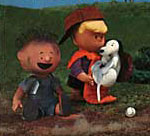 EG: Now here’s an interesting thing: Martha Armstrong Hand actually did 3D Peanuts for ViewMaster, and it wasn’t bad. I mean, it was a little weird on some of those three-quarters.
EG: Now here’s an interesting thing: Martha Armstrong Hand actually did 3D Peanuts for ViewMaster, and it wasn’t bad. I mean, it was a little weird on some of those three-quarters.
AN: I had that, and the one I remember is when Lucy’s trying to get Schroeder’s attention and bashes his Beethoven bust so he goes to the closet to get out a new one.
EG: Yeah, but Martha got all the poses from the comic strip that it was based on. That great baseball swing was Schulz’ pose. So, I think they did a very creditable job in trying to do that. I agree with you in that they’re better hand-drawn, but when you’re going to go that distance then do it as well as you can. Her Warners stuff, it was the first reel that came out, it had two Bugs Bunnys, I’m trying to think of the third one now, but basically the one that sticks out in my mind was called The Chiseler, where Bugs and Elmer were trying to sculpt something. Bugs kept getting frustrated and Elmer just kept hacking away at his and when he put it up they thought it was modern art. The characters work fantastic in there; Bugs looks completely on model; Elmer looks completely on model. They’re just gorgeous. I don’t know what drawings she had to work with, but they are stunning and that’s why I don’t buy all this knee-jerk resistance to doing classic cartoon characters in three dimensions, because they can look marvellous in three dimensions. They can look bad too.
AN: You said when we last met that the Roger Rabbit test you did looked really good.
EG: It did look really good.
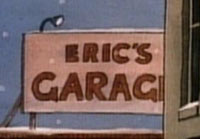 AN: Okay, I have one last question to ask: Ziggy’s Gift, and I’m asking because I saw an interview where you said, “Nobody ever asks me about Ziggy’s Gift.” I don’t know of any real controversy in connection with it, so maybe that’s why people don‘t think to ask about it. Was there anything?
AN: Okay, I have one last question to ask: Ziggy’s Gift, and I’m asking because I saw an interview where you said, “Nobody ever asks me about Ziggy’s Gift.” I don’t know of any real controversy in connection with it, so maybe that’s why people don‘t think to ask about it. Was there anything?
EG: Actually, there was a controversy. Of all people, I upset Art Babbitt and I certainly didn’t intend to. There is a butcher character in it, animated largely by Tom Roth, who has an ethnic accent, and Art thought it was anti-Jewish.
AN: But wait, you’re-
EG: I know, I’m Jewish. And the butcher’s voice in that sounded to me like an amalgam, he’s kind of part-Jewish, part-Hungarian; in fact, we were basically thinking he was Hungarian. He was a little of everybody, and the guy who did his voice was an Italian, Tony Giorgio. There was also the voice of a TV host in Cleveland that Tom Wilson remembered and that was the kind of voice that he wanted for the butcher. So, for it to come back to me second-hand that Art thought I was doing something anti-Jewish was like, “You’re kidding!”
AN: I saw the graffiti on the wall in Ziggy’s Gift that says “Eric Loves Susan.”
EG: Actually I didn’t put that in; the background artist Jean-Maxine Perramon put that in. He’s talking about the two of us, of course. We married on that film. There’s also an “Eric’s Garage” in there, which Kevin Petrilak put in; he was doing some layouts for me.
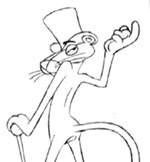 AN: So tell us about the Pink Panther titles.
AN: So tell us about the Pink Panther titles.
EG: Well, they were directed by Bob Kurtz, and they definitely bear his stamp on both humor and character design, especially the Clouseau character, which is pure, unadulterated Bob. Bob actually has a history with the character, because he wrote some of the Panther’s classic cartoons – remember The Pink Tail Fly, where the Panther engages a fly in a karate match and the fly wins? That’s Bob. Bob asked me if I wanted to animate on the sequence, and I said, yes, absolutely. First, I love the character; second, I love Bob; third of all I wanted to do Friz Freleng and Ken Harris proud. Ken animated the Panther in both the very first title sequence, and in Dick Williams’ Return of the Pink Panther titles. Bob gave me all the dance sequences, like his tango with Clouseau, and characteristic walks. I tried really hard to get the Panther’s classic step, hop-step walk just right. We didn’t have a lot of time to do them – what else is new? – but I’m pleased with the way they turned out.
AN: Okay, jumping from the past to the future. With everything happening in animation right now, what do you think the future holds?
EG: The future holds as much as we can make out of it. For me and Susan in particular it hasn’t been easy; we’ve been basically doing small jobs here and there, some larger ones. We’ve been trying to get our own independent projects off the ground, but it’s difficult to get anybody to part with money. But let’s put it this way: ever since I left Disney’s I haven’t stopped drawing. Most of the work I have done has been hand-drawn animation. It gives lie to the idea that “2D is Dead.” It’s like Mark Twain who said, “Rumors of my death have been greatly exaggerated.” Now I’m turning into Chuck Jones by quoting Mark Twain! In any case, I have had a thin stream of work for the last four years and most of it has been hand-drawn. The fact is there is still plenty of work out there but it has evolved back to 1975 to the migrant farm worker situation again. At least I’ve been there before so I know how to deal with it, but it’s not easy. Now, as far as the future goes, I think we’re going to start to see a sea change. I think, without naming any names, there are going to be enough crappy CG movies that come out in the next couple of years that will level the playing field and the novelty bloom will be off that particular rose, and now that you’ve got John Lasseter at Disney’s, I know he’s a champion of hand-drawn.
AN: I know we don’t want to get too much into that but it seems like people thought, “Oh, he’s making Toy Story and A Bug’s Life with computers so he probably thinks computers is where it’s at.” But he always wanted to see others making hand-drawn animation.
EG: Yeah, and he’s always been very supportive in print saying there’s room for both. He and Brad Bird have both said that. I think the best news about John being at Disney’s is that, from everything I’m hearing, he wants Disney to be Disney, whether they’re doing CG or they’re doing hand-drawn. There are values and principles and skill levels that need to be continued as part of that place’s legacy and I think he’s going to see to it that that occurs, and hats off to him.
——————————————————
AN: And now you’re back there at Disney again. Can you tell us a little about going back and what the atmosphere is like with all the changes going on? Is it really a case of boosted morale?
EG: We had been in touch with Don Hahn and Dick Cook during the time that we had been gone from Disney’s, Susan and I, and Dick Cook kept saying, “The winds have to change, etc., etc.,” but what happened was, once the Pixar merger took place, people were talking and John Lasseter said, “Well, he should be back here, shouldn’t he?” And Don Hahn, who has always been very supportive, said yes and he was the one who made the phone call. He sent an e-mail to Roy Disney saying, “We’d like to bring Eric Goldberg back to be Eric Goldberg.” And Roy Disney e-mailed back, “Good casting.” Basically they’re having me back as an all-purpose animation guru. I’m doing some lunchtime lectures at the studio. I’m doing some storyboarding. I’m trying to get my hand in the shorts program, and various other things that the studio wants me to do before I settle on whatever the big project will be, and that’s really a nice position to be in, let’s put it that way.
AN: Sounds kind of fun.
EG: Yeah, it is fun. And of course the studio is trying to get back on track with its hand-drawn program, and so occasionally they’ll pull me in to try out a piece of software or to talk about 2D pipelines and things like that. There are people that are far more knowledgeable at that than I am but I’m there right now.
AN: So you’re not the head of the shorts program but you might have some involvement with it?
EG: Chuck Williams is heading up the shorts program and as such the shorts that the studio will commit to have to go through both the story trust that we have in the studio and John Lasseter and the Pixar story trust. So far we have a few in development but nothing’s got a definitive green light yet. There’s a couple we are moving forward with at the moment in terms of developing the story. And my main interest, aside from the fact that I like the shorts medium very much, would be if they want to delve into the classic characters, if they want to do Mickey, Donald and Goofy. So that’s the kind of stuff that I would find very fun to work on and bring back to the screen.
AN: You know what? I think we’ve gone through this whole thing without mentioning Aladdin or Pocahontas.
EG: Yay!
AN: And I like both movies!
——————————————————
This interview took place on April 1, 2006, in the open-air seating area between the Starbucks and the original Bob’s Big Boy in Toluca Lake with a follow-up visit July 29, 2006, at Don Cuco’s Mexican restaurant, also in Toluca Lake. Special thanks go to Bert Klein for facilitating the interview and suggesting a continuation of the prior interview, to my Animated News colleague Ben Simon for working the raw transcripts into a presentable format and writing the intro to this piece, and to the MTR Corporation for their permission to use still shots from A Monkey’s Tale. Extra special thanks go to Eric himself for agreeing to and participating in this interview and fielding many questions afterwards. His love and in-depth knowledge of the art, science, and history of animation is readily apparent in any conversation.
Following are three exclusive, first-look screen shots from A Monkey’s Tale:



Following are four screen shots from the Pink Panther DVD. The first is a CG test that was done by another company before Bob Kurtz was asked to take over and render the titles in hand-drawn animation:
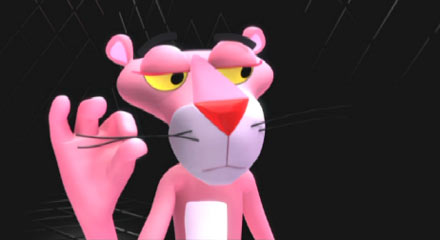
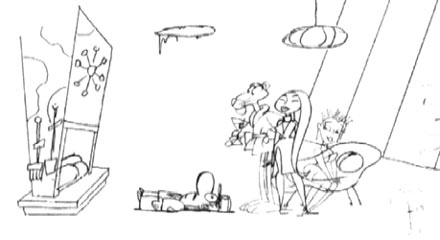
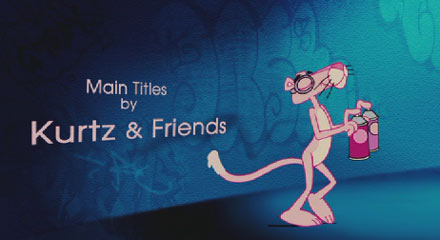
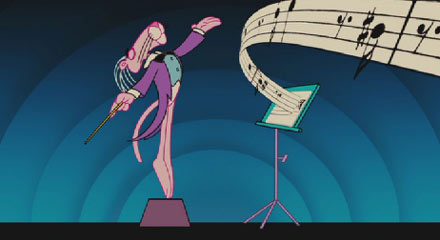
Following are eight screen shots from scenes specifically identified by Eric as ones he worked on:
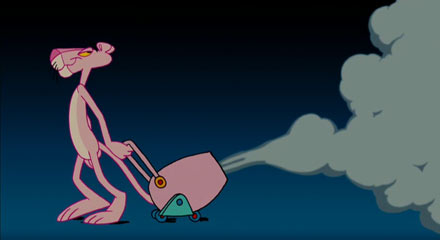
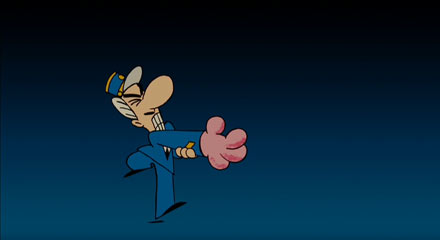
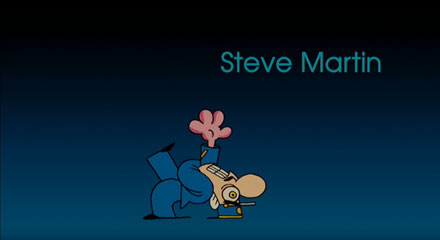
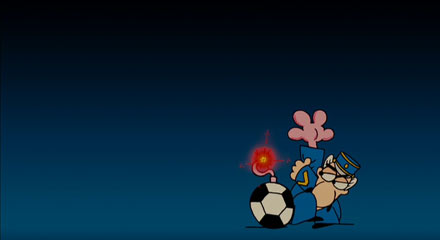
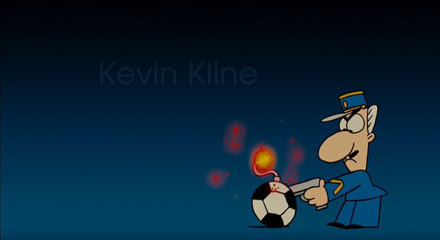
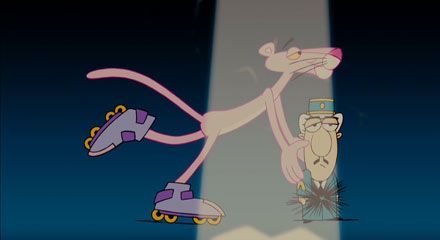
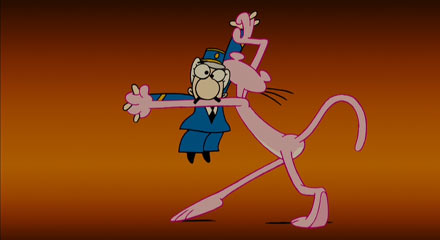
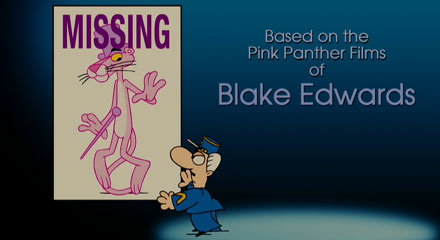
The following is a CG image of Roger Rabbit briefly mentioned in the interview and was obtained from Google Image Search:
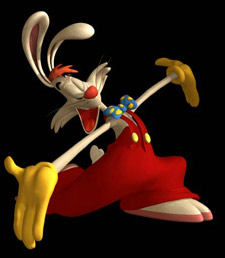
© Copyright Disney
For more of Eric’s recent works check out his commentary tracks on the upcoming Looney Tunes DVD set and his contribution to Drew Carey’s Green Screen.

